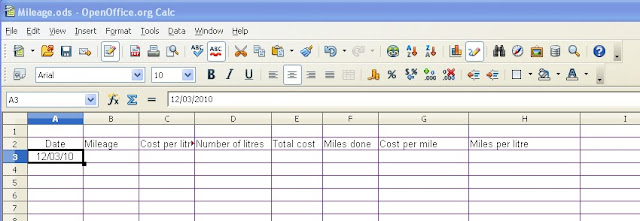We are nearly at the end of our formatting on the spread sheet, all that we want to do now is make the column headings all bold. To do this left click on the number 2 (indicating the second row) on the left hand side of the spreadsheet, highlighting the whole row. Now simply look to the formatting toolbar for the B button (See Below) and left click on it, the effect is to make all in the row BOLD.
 |
| The 'B'old button |
Formulae
Now to the more interesting side of the spreadsheet creation, the formulae.
Let's get into the first.one
Left click in the E3 cell, now type in exactly as shown below and we will go through it after.
=C3*D3
 |
| Here you can see the calculation being entered - at this point the 'Enter' key has not been pressed |
Now for the explanation, all formulae start with an '=' sign, this lets the Calc know that what follows is a calculation. These can be simply calculations, such as the one we have just typed in, or a conditional one (one of several outcomes), or very complex multiple formulae.
OK so back to the formula (calculation), the C3, and D3 labels are clearly referring to the cells C3 and D3.
It may be no shock to any of you at the '*' (to get this character hold down the 'Shift' key -sometimes just an up arrow - and press the '8' key on the top row of the keyboard) is a multiply symbol. So this formula just multiplies the C3 content by the content of D3 and puts the result in E3.
An example would be C3 contains £1.10 and D3 contains 30.0
The result is £33.00
Now to G3
=E3/F3
I am sure you can work out what is going on here. The differences from E3 are that this one uses the result of another calculation (E3) and the use of the '/' for division (E3 used the '*' multiply sign)
An example would E3 contains £33.00 and F3 contains 100
The result is £0.33
Finally H3 is
=G3/D3
No explanation needed here as it is very similar to G3
 |
| The remaining formulae have been added here - note that the cell g3 contains a bold result, this is because we set all of column G to be bold in our formatting session. |
So that is the basic formulae created, but how to create the same formulae down the sheet, with the right cells being used. Spreadsheets, are designed to calculate and multiple similar calculations are a feature of most spreadsheets. They have an easy method of replicating cell formulae.
To replicate the formula in E3 down the E column to E20, simply left click on the E3 cell and you will notice that the cell border becomes black and a small black square on the bottom right corner appears (see below). Left click and hold the left mouse button down on this little black square. Now drag the square down the E column to cell E20. Now you can let go of the button. The E column from E4 to E20 now has £0.00 in the cells.
 |
| The mouse pointer, pointing at the 'black box/ for copying formulae down the column (or across the row) |
 |
| Copying the initial '=C3*D3' formula to give a column of £0.00 |
This looks untidy, and the astute amongst you may remember that the formatting of numbers allowed you to turn off the leading zero, but unfortunately this does not work leaving £.00 in the cells instead.
There is a slightly more complex formula we can use instead of just
=C3*D3
The upgraded formula is a conditional formula as shown below
=if( D3=""; "";C3*D3)
Put this in the E3 cell, to do this you will need to remove the existing formula, so left click in E3 then press the delete key on your keyboard. A 'Delete Contents' window opens and for now just hit the 'OK' button.
 |
| What pressing the 'Delete' key does in Calc |
Now type the formula below into the E3 cell exactly as you see it
=if( D3=""; "";C3*D3)
Note that the separators are ' ; ' and not ' , ' or ' : ' (Excel uses the ' , ' )
 |
| Putting in the conditional formula |
Once that is complete, use the black square on the bottom right hand corner of the E3 cell to copy the formula to all cells down to E20. The cells will now show nothing until the appropriate D cell has a value.
 |
| After the conditional formula has be added to cells E3 to E20 - Note the little black box |
Have a think on this and next time we will go through the reasoning for this and how it works.
Thank You
Prometheus1618
We now have a FREE SPYWARE REPORT available, yours to keep and share if you wish. Fill in your details below and get yours now


